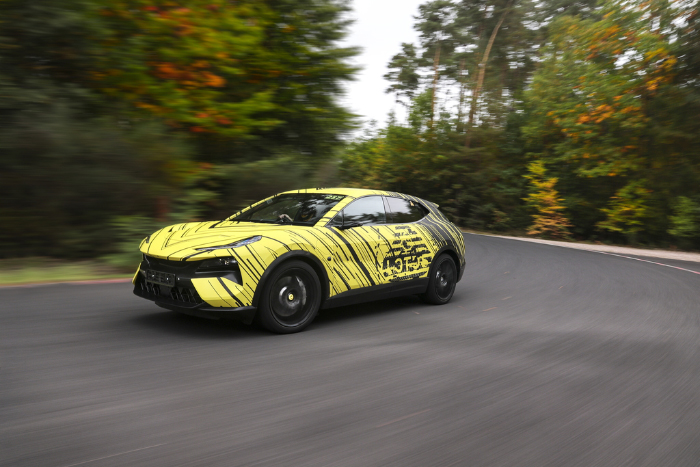All were successful for both the client and for Lotus; commercially, for brand and reputation-building and, in two out of three cases, in the world of motorsport. The Cortina won multiple touring car championships while the Sunbeam took the manufacturers’ title in the 1981 World Rally Championship.
In the late 1990s the Vauxhall Astra proudly advertised the association, with ‘Handling by Lotus’ displayed across UK billboards. The 2015 Hyundai Genesis was another premium car that acknowledged Hethel’s input, with the lead vehicle dynamics engineer from Lotus even joining in the media launch activities in the USA. A few cars have even carried a ‘Handling by Lotus’ badge, with the cult Proton Satria GTI and the Isuzu Piazza the two best-known for this.
In 1992 another Lotus Engineering dynamics project was given a public launch. Structure, Isolation and Dynamics Research – better known as SID – was an amalgamation of two engineering groups, bringing together their expertise to reinvent ride and handling development. A composite monocoque with Lotus Esprit bodywork (the Structure) sat on a unique backbone chassis supporting a 300bhp turbocharged V6 MG Metro 6R4 powertrain (through various tuneable elements, the Isolation), it was a technical tour de force – a rolling test bed for Lotus-developed active suspension, active ride, four-wheel steering and four-wheel drive (the Dynamics). Clever algorithms meant it could showcase each of its technologies one at a time or all together, and SID included a digital controller which meant every suspension parameter could be modified at the touch of the laptop keyboard, even while on the move. That in itself was an achievement, for the first time enabling the data to be captured and downloaded for further analysis.
Importantly, it allowed the SID team to plot dynamic inputs against driver experience – what was it that created ‘that special feeling’ in the person behind the wheel? – which was crucial to improving dynamic understanding for clients of the Lotus Engineering consultancy, but also Lotus itself.
Today, this is part of the many decades of learning which have influenced what Lotus knows about active and passive systems. The five-link suspension at the rear of the Eletre Hyper-SUV launched earlier this year is a great example of that progression. Featuring multi-chamber air suspension with continuous damping control, a 48v anti-roll system, torque vectoring and an active rear axle (depending on model) with a selection of drive modes, it integrates dynamic excellence into a completely new class of Lotus vehicle.
Gavan Kershaw, Director of Vehicle Attributes, has been at Lotus for 34 years and is responsible for ensuring every new Lotus car the right dynamic personality. He explained: “At Lotus we’ll never use electronics as a sticking plaster for a poor architecture or chassis, but we can make a vehicle like the Eletre feel as nimble as the Elise because we understand technologies such as rear-wheel steering, active roll control and active damping.”
The Lotus dynamics team knows the difference between a car that handles well, one that doesn’t, and all the nuances in between. This experience, and working in tandem with the client to meeting its requirements, means Lotus Engineering can offer the full package of dynamics services, all the while ensuring that the product requirements are cascaded into technical targets that can be managed and tracked throughout the delivery programme.
Mark Stringer, Commercial Director for Lotus Engineering, leads strategic planning and delivery of external Lotus Engineering projects, and has brought a fresh focus on to offering advanced technologies and services to clients. “We’re hugely proud of our reputation for cars with exceptional handling, and SID is an excellent example of how our innovative approach across multiple disciplines delivers ingenious solutions.”
He added: “Our services in dynamics can support clients looking to utilise our broad experience in both the traditional automotive industry, and the wider field of intelligent mobility to deliver innovative solutions into their market sector. As the world moves into the all-electric era, and with the prospect of fully autonomous vehicles getting ever closer, there is no reason why companies should compromise on dynamics. Striking the right balance between comfort, safety and an exceptional experience for the driver or other occupants is where Lotus Engineering continues to position itself.”
Lotus Engineering provides comprehensive consultancy services to many of the world’s OEMs and Tier 1 suppliers. It is internationally recognised for its long-standing contribution to ground-breaking engineering and innovative vehicle development. The four core pillars of its expertise and its commercial offering are Platforms, Control Systems, Dynamics and Technical Services. The latter includes intelligent design, product concept development, attribute development, advanced engineering and even whole-vehicle manufacturing.

COMMENTS